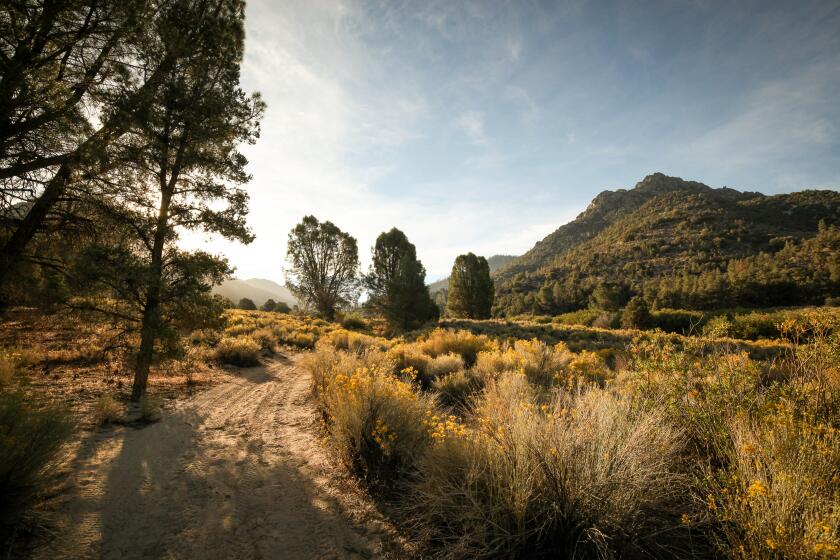‘Enduring Wild’ is an engaging travelogue about California public lands under attack

- Share via
Book Review
The Enduring Wild: A Journey into California’s Public Lands
By Josh Jackson
Heyday Press: 264 pages, $38
If you buy books linked on our site, The Times may earn a commission from Bookshop.org, whose fees support independent bookstores.
Josh Jackson’s “The Enduring Wild: A Journey Into California’s Public Lands” is a story of adventures across 41 California landscapes, with photos of beautiful places you are unlikely to have seen, in locations ranging from the Mojave Desert to the Elkhorn Ridge Wilderness in Mendocino County. Early on, the author lays out mind-bending stats: more than 618 million acres in the United States are federally owned public land and 245 million of those belong to the Bureau of Land Management.
Public lands, he notes, “are areas of land and water owned collectively by the citizens and managed by the Federal government.” These lands “are our common ground, a gift of seismic proportions that belongs to all of us.”
Drive across the United States and consider that 28% of all of that is yours. Ours.
Jackson’s assertion that we are all landowners is a clarion call amid a GOP-led push to sell off public land. The shadow of the current assault on public lands weighs heavy while reading this lovely book.
The book has endearing origins. When Jackson could not get a reservation for weekend camping with his kids, a buddy suggested that he try the BLM. Until that moment he had never even heard of the Bureau of Land Management. Yet, 15.3% of the total landmass in California is … BLM.

Jackson starts out with history: All these lands were taken from Native American peoples, and he does not overlook that BLM used to be jokingly referred to as the Bureau of Livestock and Mining. In 1976, a turnaround came via the Federal Land Policy and Management Act, which built a multi-use mandate to emphasize hiking and conservation as much grazing and extraction (a.k.a. mining). This effort to soften the heavy use of public lands by for-profit individuals and companies led to the so-called Sagebrush Rebellion and the election of President Reagan. Arguably, we’ve been struggling with finding the multi-use balance ever after.
For 120 years, America’s public lands policy has emphasized ‘the greatest good of the greatest number.’ ‘Drill, baby, drill’ isn’t that.
Jackson’s first BLM foray was out to the Trona Pinnacles in the Mojave Desert, where he and his two older children camped, playing in a wonderland where “hundreds of tufa spires protrude like drip-style sand castles out of the wide-open desert floor that extend for miles in every direction,” while his wife, Kari, an E.R. nurse, stayed home with their newborn. The pandemic shutdown in 2020 inspired Kari’s suggestion, “Why don’t you start going to see all these BLM lands?”
Jackson’s love affair with BLM lands was not immediate, as just a few miles into his next hike in the Rainbow Basin Natural Area near Barstow, he was underwhelmed, like he was missing something. A few miles later, he sat and considered a Terry Tempest Williams quote from “Refuge”: “If the desert is holy, it is because it is a forgotten place that allows us to remember the sacred. Perhaps that is why every pilgrimage to the desert is a pilgrimage to the self.” Revisiting this quote on repeat, Jackson had an emotional shift, deciding to stop hiking and … start walking.
On his next trip to the Amargosa Canyon, Jackson began by reaching out to the Amargosa Conservancy, learning about the Timbisha Shoshone people whose ancestral land this is, about past mining and dozens of plant and animal species. Committed to going at the pace of discovery, he admired the enchanting, striated geology of Rainbow Mountain, cherished creosote, mesquite and the brave diversity of desert flora and was struck by the gaze of an arrogant coyote. On his return, he found that in three hours, he had only traveled … a mile.
Yet it was during this meander that his writing made a steep drop into seeing, feeling, connecting, plunging toward transcendence.
A highlight of the book is a repeat trip to Central California’s Carrizo Plain, first during a drought, silenced by its sere magnificence. After the heavy rains of 2022, he joined Cal Poly San Luis Obispo botanist Emma Fryer and was overcome by the delirious beauty of a superbloom, feeling like “I had wandered into the Land of Oz.” Fryer observed that the drought was so severe that only the hardy native seed survived within the soil, releasing their beauty the moment water allowed them to come to life. Seeing the same place twice was revelatory, both familiar and completely new.
It’s hard to tell if the places he visits gets more beautiful over the course of the book or his capacity to appreciate them and share his joy has grown. Despite the frequent paucity of BLM cartographic resources, apparently Jackson never got lost or worried about dropping the thread of a trail. Describing his father, Jackson might as well be talking about himself: “I have no memories of my dad being worried or fearful in unfamiliar situations.” Nevertheless, toward the end of the book, when he and his hardy father camped next to the rushing Eel River, Jackson did worry about bears breaking into their tent. Fortunately, the bears did not arrive but, inspired by William Cronon’s “The Trouble With Wilderness,” Jackson’s heart opened as he realized that “Nature” is not out there; nature is wherever we are.
Joshua trees cascading like waterfalls. Colorful medleys of sagebrush. Incredible displays of wildflowers. All can be experienced on public lands managed by the Bureau of Land Management.
Back in Los Angeles taking long walks with his daughter, past bodegas and car washes, he saw jacaranda, heard owls and coyotes and realized the wild had been here all along. An urban sycamore claimed its space regardless of enclosing cement and car exhaust, as spectacular and venerable as any sycamore in the state.
Can the places Jackson visited for his book endure public larceny? He is tracking the answer to this question, real time, on his Substack, where he’s currently describing the shocking attempts to sell millions of acres of BLM land.
“It’s been a wild few weeks for BLM lands. 540,385 acres in Nevada and Utah were on the chopping block to be sold off,” Jackson recently noted. “Everyone was talking about the land totals — but no one was showing what the landscapes actually looked like. So, I decided to go see them.”
Great advice: Bring a friend, pack water and go.
Watts’ writing has appeared in Earth Island Journal, New York Times motherlode blog, Sierra Magazine and local venues. Her first novel is “Tree.”
More to Read
Sign up for our Book Club newsletter
Get the latest news, events and more from the Los Angeles Times Book Club, and help us get L.A. reading and talking.
You may occasionally receive promotional content from the Los Angeles Times.











